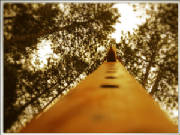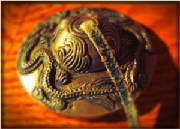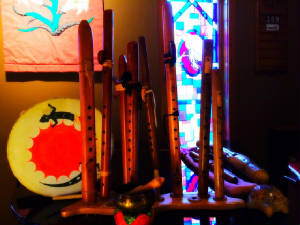|
About the Instruments
In addition to playing guitar, keyboard instruments, and
singing, Christian plays Native American flutes, and instruments from other cultures. This section describes these
instruments that he uses in recordings, performances, & therapy.

The Native American Cedar Flute
The cedar flute originated with Woodland American Indian nations and eventually migrated
to the Plains Indians. The tradition of the Cedar flute is improvisation. While some melodies handed down through oral tradition
exist in vocal music and some flute music, native flute melodies are mainly improvised. A flute player is to play what is
in his or her heart- in the moment. This was the reason the flute was often played as a part of courtship.
The other use for the flute was and is in the creation of a sacred, prayerful, and meditative
space for the player and those who listened. The Cedar flute's haunting, yet gentle tone, combined with simple, soulful melodies
make it the perfect calming and healing instrument.
I have found this instrument very effective in helping people cope with pain, stress,
anxiety, chronic conditions, and terminal illness. One hospice patient described this as her "crossing over music" and she
did "cross over" while I was playing for her. Others have told me the flute calmed them more than anything else (including
sedatives) did. The flute is very effective at creating imagery and connecting us to the peace of the natural world
and within ourselves. When I play for myself, for a patient, or for a large group of people, I find it very centering and
consider it a form of prayer.
| Native American Cedar Flute |
|
|
Drums, Rattles, & Shakers
Communication, Community, & Healing-
In ancient and indigenous cultures the drum is considere sacred. It has three basic
and interconnected functions: Communication, Community, & Healing.
In many parts of Africa, one can still find very large drums positioned throughout forest
regions. Often these would be placed near bodies of water for amplification purposes. These drums occur in a network, through
which messages may be relayed long distances. Aboriginal, African, and some American Indian people have employed a wide variety
of percussion instruments used to facilitate communication.
In many cultures, the drum has been used for bringing communites together for prayer,
religious ceremony, celebrations, and important events. When gathering around a drum most traditions involve the circle. The
circle is representative of the cycles of life, but it also creates an equality among all of those gathered. No one person
is closer to the center and the power of the drum.
Drums and percussion are also used for healing in shamanic cultures. Frame drums and
rattles are frequently used by many groups, while hand drums are used by others. One way that the drum is used
in healing by traditional healers as well as modern music therapist is through the concept of entrainment. "Discovered"
in the 1600's by physicist Christian Huygens, Entrainment describes the phenomenon by which two bodies in motion in close
proximity will move together, or entrain. A healer first matches the rhythms of the body and gradually changes the rhythm
to one that is more healthy. Another way the drum is used is to play certain rhythms to induce specific states of awareness.
Modern research has shown that specific rhythms can induce specific states of consciousness. This process is sometimes referred
to as "auditory driving". These states of consciousness can be used to facilitate healing and reduce senstations of pain,
anxiety, or discomfort.
Talking Drum
This is a portable instrument from West Africa in the shape of an hourglass with heads
on either end. Long strands connect the two heads. The pitch may be changed by applying pressure on the strands while playing.
Master talking drummers can make it sound as if the drum is speaking and in some places a language for the drum was actually
developed.
Log Drum
Some of the very first drums, and very first instruments for that matter, were likely
hollow logs which were played with sticks or hands. Later slits were added to create a variety of pitches. This is a fun instrument
that creates a variety of sounds with a warm tone.
Hand Drums (Djembe, Conga, Ashiko, Tubano, Doumbek)
These have been used in several cultures for different purposes, but they are assiciated
mostly with African and Arabian cultures. Rhythms could be played to go with a particular time of day and for specific
ceremonial reasons. Instruments such as the Conga later became an influence in Latin music traditions as well. These instruments
are played with the hands and create a wide range of tones depending on the shape of the hand and the angle at which it hits
the drum.
Frame Drums
From the healers of Tibet, to the healers in ancient Celtic traditions, to the healers
of the Plains Indians, frame drums are a nearly universal instrument. They are used in both sacred and secular traditions.
They are a simple instrument: A wooden hoop, with a head on one side, and a support frame made of wood or animal hide. The
instrument can be played with hands, but most often with a padded mallet. They can vary in materials and tone, but they are
basically quite similar in most traditions. These instruments are also wonderful for self expression.
Medicine Rattle
In shamanic traditions, medicine rattles and shakers are used in a similar way to drums-
often as part of the consciousness-altering process. Often rattles are played near part of the body that may be experiencing
discomfort. Also used in prayer and meditation, they are considered sacred instruments.
Rain Stick
Variations on the Rain Stick developed in parallel at the same time in Africa and South
America. In both cases, rainsticks were a way to meditate on the life rain brings, and to pray for rain. Christian has quite
a collection of rainsticks, and often invites listeners to participate by playing them.

Tibetan Chimes, Singing Bowl, and Gongs
In Tibetan tradition, Tingsha Chimes (pictured here) were used to help clear the energy of a space
for prayer and meditation. These chimes are like a pair of large "finger symbols", only larger and more resonant, that
are played by striking them gently together. Singing bowls are used to help people center. They are in the shape of
a bowl, with a wooden mallet that can be used to gently strike the bowl, then to run along the upper lip to sustain the vibration.
It is a unique sound that can help get people in a meditative frame of mind. Gongs are also used in meditation and to mark
transitions in ceremony. These instruments are very powerful tools in creating a sense of ceremony in an event.
____________________
____________________
|


